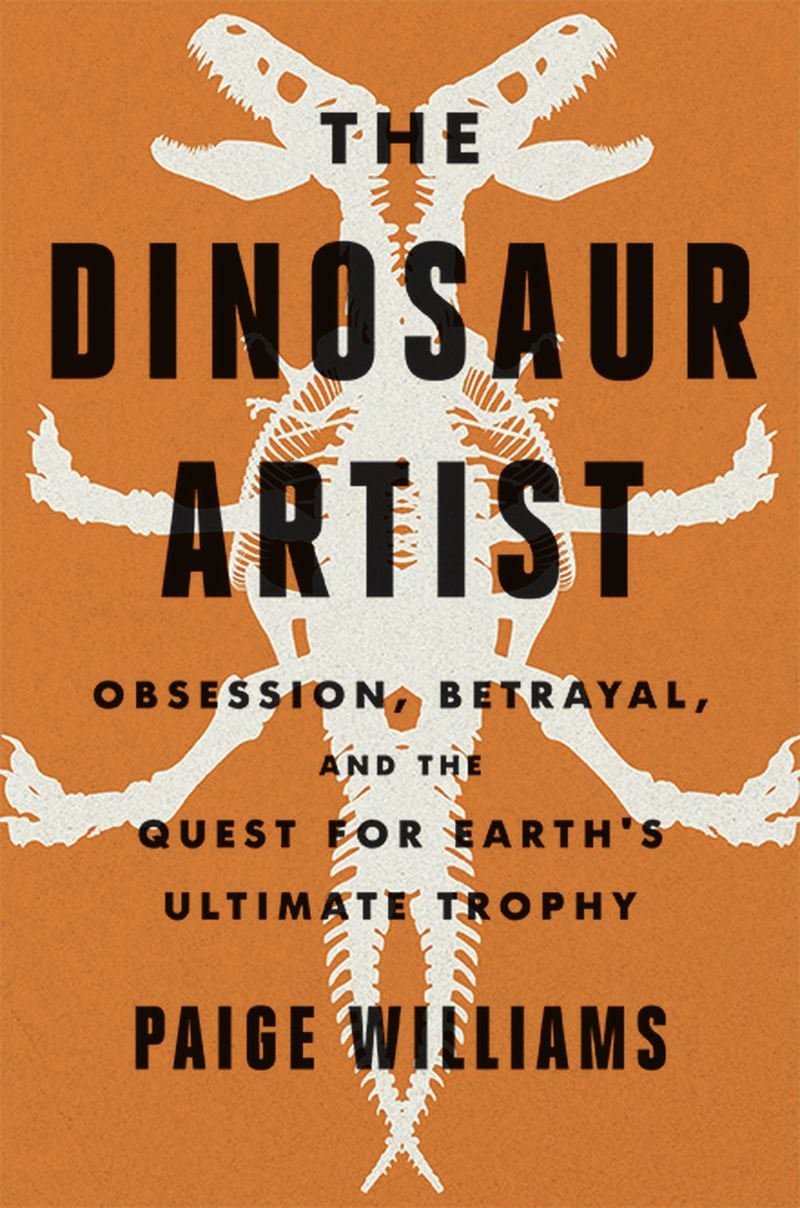It’s hard to imagine a legal case with a more intriguing title than “United States v. One Tyrannosaurus Bataar Skeleton.” The 2013 asset forfeiture case centered around a 24-foot-long fossil that had sold for more than $1 million at a New York auction. A restraining order from the government of Mongolia, the likely place of origin for the bones, halted the transaction and cast the seller, fossil dealer Eric Prokopi, as either a nefarious international smuggler or a passionate but misguided fan of paleontology.
With details involving runaway dinosaurs and adventures in remote, dangerous locales, the story evokes the likes of Indiana Jones and Jurassic Park. With her first book, “The Dinosaur Artist,” Mississippi native Paige Williams expands her New Yorker article to dig beneath the surface into the many fraught issues, quirky individuals and historic epochs that inform the case.
Subtitled “Obsession, Betrayal and the Quest for Earth’s Ultimate Trophy,” the book takes an enormous amount of complicated material and, well, doesn’t exactly make it simple. “The Dinosaur Artist” is a rewarding read but often a demanding one. Williams does justice to the complexities of its ideas, which include the tension between amateur, professional and scientific fossil collectors, U.S./Mongolian relations and the rightful treatment of prehistoric artifacts.
As Williams says in her author’s note, “I tried to convey the nuances of the debate over who owns, or should be allowed to collect and own, natural history, and how that conflict may in turn affect a range of interests, including public policy, science, museums and geopolitics.”
The title partly applies to driven but taciturn Prokopi as Williams traces how a childhood collecting shark’s teeth in Florida inspired a lifelong love of finding, restoring and selling fossils. At one point Williams explains the practice of “deadheading,” which involves searching deep rivers to salvage sunken logs that had been cured over decades in silty floors. The author conveys the risks in a few efficient, nail-biting paragraphs.
“Below the surface, sunlight instantly disappeared. Silty murk rose up to meet the divers as they descended, levels of diminishing visibility that (‘How to Do Florida’ TV show host Chad) Crawford said ‘redefined dark.’”
Prokopi goes from selling his finds at fossil shows to engineering international deals, with his household’s increasing expenses spurring the need for bigger payouts. He ends up buying multiple fossils with the help of a Mongolian middleman, without asking too many questions about the legalities. On shipping documents, he refers to dinosaur remains likely to be worth a fortune as “two large rough fossil reptile heads,” a statement that’s arguably true and inarguably misleading.
Like the metal armature that provides the frame on which to display full dinosaur skeletons, Prokopi’s life, travels and legal jeopardy give a structure on which Williams hangs anecdotes and digressions. Prokopi’s initial interest in the Mongolian market leads to chapters on the country’s history. Williams compellingly captures the conquests of Genghis Khan, the 1920s expeditions of U.S. explorer and media darling Roy Chapman Andrews and Mongolia’s turbulent post-Communist politics. An area of the Gobi Desert called The Flaming Cliffs becomes an especially memorable destination as a jackpot for fossil discoveries.
Williams draws fascinating connections between time periods, such as high-profile dinosaur auctions in the 1920s vs. the 1990s (the latter involving movie stars Nicolas Cage and Leonardo DiCaprio). Sexism in the scientific community, sadly, seems to span continents and centuries, befalling both prodigious amateur paleontologist Mary Anning on the 19th century coast of England as well as Bolortsetseg Minjin, a contemporary Mongolian scientist snubbed by her peers in her native land. A tireless advocate for Mongolian fossils, “Bolor” blew the whistle on Prokopi’s attempted sale, setting the book’s events in motion.
“The Dinosaur Artist” infectiously captures mankind’s fascination with fossils as both tangible items to treasure and artifacts that can reveal a wealth of data about the planet’s prehistory, geology, zoology and more. The book’s bones of contention, a skeleton of a Tyrannosaurus Bataar (also called a “Tarbosaurus”), showcase an intriguing animal comparable in size and predatory ferocity to the T. Rex but lesser known until the legal wranglings put it in the spotlight.
Nevertheless, “The Dinosaur Artist’s” many themes and storylines hinder it from becoming a natural history account as accessible as a volume like Bill Bryson’s “A Short History of Nearly Everything.” The book’s organizational structure seems perfectly justifiable yet leads to convoluted sections with rival scientific, legal and governmental stakeholders on two hemispheres. Side characters have walk-on appearances, vanish for a hundred pages and return with no preamble. Sometimes books like this provide narratives that propel the reader over dense jargon or confusing acronyms, but “The Dinosaur Artist” juggles too much to build that kind of momentum.
The reader also gets the impression that Williams’ exhaustive reporting is hindered by sources who were either dead, elusive or just cranks: at times she seems to be writing around some sketchy details. Flipping back and fourth to the source notes, you wonder if the author could have clarified some matters by making herself part of the story, directly explaining what she saw in person, learned through social media or found to be dead ends. Or maybe there’s no way to convey the story more cleanly without oversimplifying its essential conflicts.
But “The Dinosaur Artist” undeniably kindles the reader’s interest in its subjects and can lead you to research its key players, visit a museum or even join the hunt for fossils to unearth your own bit of history.
NONFICTION
‘The Dinosaur Artist’
by Paige Williams
Hachette Books
410 pages, $28
About the Author







